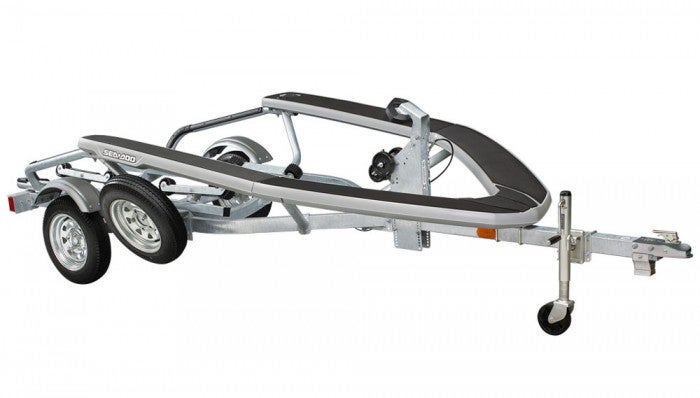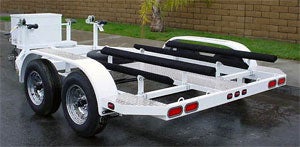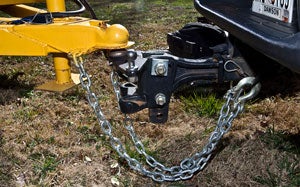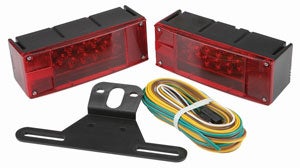What To Look For In A PWC Trailer

The right trailer will make towing your craft easier for years to come
Most of us spend a lot of time considering the specs, features and benefits of a new PWC model before buying. We rarely spend a fraction of that time considering the trailer that will carry it to the water.
That toy hauler, however, has a lot of responsibility. And as such, you should know what to pay attention to when buying it.
Here’s a primer on what to look for in personal watercraft trailers…
Make It A Single…Or A Double

One obvious decision that needs to be made early on is how many bunks your trailer should include. If you have one craft, and don’t plan on ever getting another, a single-place trailer is fine. But think twice before making that decision.
Do you have a wife, husband, or significant other that you might add a second craft for in the future? Do you want to be able to team up with a buddy and head out to the water? Think you might just add a second craft for yourself? If any of these answers are yes, or may be in the future, you might want to consider the second bunk now.
Painted Steel, Aluminum, or Galvanized Steel

Steel is the cheapest and most common frame material. It’s typically painted, which looks great on the showroom floor and may nicely match your tow vehicle, but be aware it takes some preventive maintenance to keep it that way. Rust is a common occurrence, especially around welded joints or in areas that have been damaged. Rust’s telltale orange stain will quickly mar the looks of that pristine finish if left unchecked.
Painted trailers are typically best in fresh water environments. For salt, galvanized steel is a better option. No, it’s not as nice looking. That shiny silver finish will dull to a flat grey as time goes on. The galvanizing process, however, will keep rust and corrosion at bay by coating the steel in a hot bath of liquid zinc. That beats paint any day.
Aluminum has many benefits. It’s attractive, doesn’t age badly over time and exposure to the environment, and is far lighter than steel. The downside? Price. Aluminum trailers are more expensive than steel. Aluminum is also typically fashioned in an I-beam construction, rather than the tubular construction of steel frames. Wiring and brake lines can’t be run inside and out of sight, but rather are attached to the exterior of the frame. If you prefer aluminum, look for conduit attached to the frame for protection of these latter items.
Cushioning The Load

Like your car, trailers offer a suspension. Most common is “leaf spring,” which consist of numerous curved, slender steel plates, stacked atop each other that flex to absorb shock. A more expensive, but arguably better system is “torsion beam” suspension, a system that uses a torsion bar as the springy component. The torsion bar is attached at one end to a metal bar at the trailer frame, and at the other to a lever attached to the axle. Shock absorption is the result of the torsion bar’s resistance, typically provided by rubber cords inside the axle’s housing.
Rollin’, Rollin’ , Rollin’…
Tires should be adequately matched to your craft and load. Look at the load index, a number/letter combo printed on the sidewall following the tire size and diameter (ex. P195/60R15 87S). Those last two numbers correspond to how much weight the tires can carry; the letter represents its speed limitations. Most trailer tires are rated R-S (106-112 mph), more than enough for safe towing at the speed limit.
Give ‘em A Brake

Your tow vehicle may stop lighter loads, but trailer brakes are certainly useful, and in many cases, required by states when the trailer tips past 3000 pounds. Hydraulic surge brakes are the most common. They’re activated when momentum is changed by the tow vehicle decelerating.
Brakes themselves can be of the drum or disc style. Drums force a pair of brake shoes against the sides of an enclosed drum, and are typically cheaper, but harder to service. Drums should also be maintained more carefully. Flush kits are available to flow water into the areas of the drum that can’t be reached with a simple spray of the hose.
Disc brakes squeeze their brake pads against a rotor located behind the wheel hub. They’re typically more expensive, but easier to maintain and less susceptible to rust and corrosion.
Securing Your Craft To The Trailer

While winches are common on boat trailers, they really shouldn’t be used to haul a craft up the trailer’s bunks. It’s too much stress. Rather, a winch can pull your craft those final few inches, and the strap is used as an anchor to secure the craft from slipping backward off the bunks, the post from surging forward in an abrupt stop. Helping in that latter area is typically a bow stop, a V-shaped rubber or composite wheel that cradles the V of the craft’s bow.
Look for adjustability both forward and back, as well as up and down in height, to fine-tune the fit to your craft.
A safety chain provides additional security. It should run from the trailer to the PWC’s bow eye to act as a failsafe should the winch break.
Other styles of bow posts exist, although they’re not as common. These include a simple U-shaped bracket with a securing pin that passes through a craft’s bow eye, or a spring-loaded style, like found on Sea-Doo’s iCatch trailers, that snaps into position upon contact.
…And Your Trailer To Your Vehicle

The trailer’s coupler secures your trailer to the tow ball on your tow-vehicle hitch. The coupler lever features a hole and typically a cotter pin to secure the lever in the closed position. Change it to a padlock to secure the trailer to your vehicle. Safety chains or cables are also required. They act as a second layer of security should the coupler somehow come off the tow ball.
An old-school trick? Crisscross the two chains or cables. That way they’ll catch the coupler if it ever came detached, rather than allow it to scrape down onto the pavement.

Let There Be Light
There’s really no good reason to buy incandescent lights in today’s LED world. LEDs have a far longer lifespan, are typically sealed against water intrusion, are brighter and easier to see, and use less energy. Look for grommets where light wiring, or brake lines for that matter, pass through metal into the interior of the frame’s tubing to protect from chafing.
Other Considerations…

Other features to consider? A tongue jack is a must to easily lower the trailer hitch on and off your tow vehicle’s hitch ball. Nobody wants to lug the trailer tongue up and down in today’s world of far heavier PWC. Jacks with wheels, instead of pads, make it easier to move the trailer around when not attached to the vehicle.
Other good ideas include some type of bearing protectors, like the Bearing Buddy, to protect the wheel bearings and make it easier to add grease; composite fenders to protect the tires, keep dirt from being flung onto your craft, and offer a step to climb onto your craft; a spare tire carrier to keep that spare tire close at hand; and possibly a swing-away tongue, which shortens the trailer’s length to make it easier to fit into a garage.
Related Reading
2012 Sea-Doo PWC Trailer Line Review
2010 Sea-Doo ADVANCED TEC iCATCH I Trailer Review
Upgrading a PWC Trailer to LED Lighting
Safe Trailering for Personal Watercraft
Get PersonalWatercraft.com in your Inbox!
Like PersonalWatercraft.com on Facebook
Comments
Most Popular

2025 Yamaha JetBlaster PRO 2-Up Review

2024 Kawasaki Jet Ski STX 160X Review

Remembering the Sea-Doo XP

Whatever Happened to the Wetbike?

2025 Yamaha JetBlaster Review












 Your Privacy Choices
Your Privacy Choices